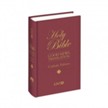Esther 8
Good News Translation
The Jews Are Told to Fight Back
8 That same day King Xerxes gave Queen Esther all the property of Haman, the enemy of the Jews. Esther told the king that Mordecai was related to her, and from then on Mordecai was allowed to enter the king's presence. 2 The king took off his ring with his seal on it (which he had taken back from Haman) and gave it to Mordecai. Esther put Mordecai in charge of Haman's property.
3 Then Esther spoke to the king again, throwing herself at his feet and crying. She begged him to do something to stop the evil plot that Haman, the descendant of Agag,[a] had made against the Jews. 4 The king held out the gold scepter to her, so she stood up and said, 5 “If it please Your Majesty, and if you care about me and if it seems right to you, please issue a proclamation to keep Haman's orders from being carried out—those orders that the son of Hammedatha the descendant of Agag gave for the destruction of all the Jews in the empire. 6 How can I endure it if this disaster comes on my people, and my own relatives are killed?”
7 King Xerxes then said to Queen Esther and Mordecai, the Jew, “Look, I have hanged Haman for his plot against the Jews, and I have given Esther his property. 8 But a proclamation issued in the king's name and stamped with the royal seal cannot be revoked. You may, however, write to the Jews whatever you like; and you may write it in my name and stamp it with the royal seal.”
9 This happened on the twenty-third day of the third month, the month of Sivan. Mordecai called the king's secretaries and dictated letters to the Jews and to the governors, administrators, and officials of all the 127 provinces from India to Ethiopia.[b] The letters were written to each province in its own language and system of writing and to the Jews in their language and system of writing. 10 Mordecai had the letters written in the name of King Xerxes, and he stamped them with the royal seal. They were delivered by riders mounted on fast horses from the royal stables.
11 These letters explained that the king would allow the Jews in every city to organize for self-defense. If armed men of any nationality in any province attacked the Jewish men, their children, or their women, the Jews could fight back and destroy the attackers; they could slaughter them to the last man and take their possessions. 12 This decree was to take effect throughout the Persian Empire on the day set for the slaughter of the Jews, the thirteenth of Adar, the twelfth month. 13 It was to be proclaimed as law and made known to everyone in every province, so that the Jews would be ready to take revenge on their enemies when that day came. 14 At the king's command the riders mounted royal horses and rode off at top speed. The decree was also made public in Susa, the capital city.
15 Mordecai left the palace, wearing royal robes of blue and white, a cloak of fine purple linen, and a magnificent gold crown. Then the streets of Susa rang with cheers and joyful shouts. 16 For the Jews there was joy and relief, happiness and a sense of victory. 17 In every city and province, wherever the king's proclamation was read, the Jews held a joyful holiday with feasting and happiness. In fact, many other people became Jews, because they were afraid of them now.
Footnotes
- Esther 8:3 See 3.1.
- Esther 8:9 Hebrew Cush: Cush is the ancient name of the extensive territory south of the First Cataract of the Nile River. This region was called Ethiopia in Graeco-Roman times, and included within its borders most of modern Sudan and some of present-day Ethiopia (Abyssinia).
Good News Translation® (Today’s English Version, Second Edition) © 1992 American Bible Society. All rights reserved. For more information about GNT, visit www.bibles.com and www.gnt.bible.
Bible Gateway Recommends









